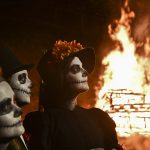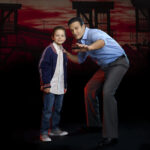BY CHRIS KALTENBACH, THE BALTIMORE SUN
BALTIMORE — Two decades have passed since three budding filmmakers wandered into the western Maryland woods, never to be seen again. Quite the cause for celebration, right?
It is when the three 20-somethings were the central characters in “The Blair Witch Project.” The shot-on-the-cheap exercise in cinematic terror, made by two rookie directors working with a trio of unknown actors, came out of nowhere in 1999 to rake in more than $140 million at the U.S. box office (on a reported budget of $60,000) and launch a craze for found-footage horror films. It also briefly turned Maryland, where the movie was both set and shot, into a mecca for horror fans anxious to see for themselves where all the grisly, ghostly happenings captured onscreen supposedly took place.
“We were completely floored,” says co-director Eduardo Sanchez, who will be in Frederick on Oct. 18 for an anniversary “Blair Witch” screening at the Weinberg Center for the Arts. “It got to the point where it was just kind of like one ridiculous thing after another happening in our lives. We knew we had kind of a cool project, but we never expected that this movie was going to make even $5 million. We never expected this movie to even be shown in theaters.”
His directing partner, Daniel Myrick, was similarly gobsmacked by the movie’s success. “We knew we had something that had a chance to be creepy and cool at an indie film level, but breaking into the mainstream? I don’t think anybody anticipated it to the degree it ended up.”
Purportedly footage shot by the three young filmmakers and discovered after they disappeared, “The Blair Witch Project” chronicles the trio’s last days. Having set out to make a film about the Blair Witch, which legend has it lurks in the woods around the Frederick County town of Burkittsville, killing people and devouring their bodies, they encounter strange sounds and mysterious stick figures, get hopelessly lost and discover, to their (and our) growing horror, that the witch’s reputation is richly deserved. In the film’s most famous (and most relentlessly parodied) scene, one of the three, a terrified Heather (played by actress Heather Donahue; the actors’ and characters’ names are the same), turns the camera on herself, tearfully apologizing for having put everyone in harm’s way like this.
Calling the movie an “exhilarating return to the roots of cinematic horror,” former Baltimore Sun movie critic Ann Hornaday, in her July 1999 review, praised “Blair Witch,” awarding it four stars and saying it “packs an emotional wallop entirely disproportionate to its meager pedigree.” Other critics followed suit (though not everyone: sniffed Kirk Honeycutt of The Hollywood Reporter, “The viewer never glimpses anything more than the shadow of a clever movie”), directors Sanchez and Myrick appeared on the cover of Time (with the cast making the cover of Newsweek), its directors and producers won an Independent Spirit Award.
A horror-movie phenom was born. “It’s pretty humbling to talk about it, 20 years later,” says cast member Michael C. Williams, now 46 and in his 10th year as a middle school guidance counselor in Westchester County, N.Y. “It was an event movie, where people are always telling me the story of where they saw it, what happened right after it, how they went into the woods and they were going camping, or how they lived in a house that was creepy, and they never went to the basement again. People remember it as an event, which is pretty neat to be a part of.”
Myrick and Sanchez agree that “The Blair Witch Project” arose from their shared love of horror movies. As students in the film program at the University of Central Florida in Orlando, Fla., they were looking for a film project when they attended a preview screening of 1991’s “Freddy’s Dead: The Final Nightmare,” an entry in the”Nightmare on Elm Street” franchise. Certainly, the pair thought, they could do better than this.
“It was really just kind of silly,” says Sanchez, who grew up in the Maryland suburbs of Washington, D.C. “It wasn’t like a horror movie that was meant to scare you. It was fun, we liked it, but we came home and were like, ‘Man, they don’t really make horror movies the way they used to when we were younger.’”

REED SAXON / ASSOCIATED PRESS FILE
Directors Eduardo Sanchez, left, and Daniel Myrick pose for a photo over a poster of their film “The Blair Witch Project,” in West Hollywood, Calif., on Friday, July 16, 1999.
Agrees Myrick, a Florida native who grew up in Sarasota, “We were coming out of film school at a time where, you know, horror was becoming pretty self-referential and almost comedic. We wanted to make something that was actually scary.”
Inspired by productions like “The Legend of Boggy Creek,” “Chariots of the Gods” and the TV series “In Search of … ” (which featured narrator Leonard Nimoy leading viewers through investigations of the mysterious and the paranormal), the pair settled on a documentary-style movie about some filmmakers who disappear while working on a project. Originally, Sanchez says, the plan was to make it a mix of footage the vanished filmmakers had left behind and new footage of the investigation into their fate. That was the plan when actors Donahue, Williams and Joshua Leonard auditioned and won parts in the planned movie.
Williams, who was living in Queens, N.Y., at the time, saw a notice in Backstage magazine. “I knew nothing more than what was listed in the advertisement,” he says, “Which was, “improvisational feature film to be shot in a wooded location, about a local legend.’ And it said, like, meals and pay. That was it, that was all I knew.”
The movie was shot over eight days in October 1997. Most of it was filmed in Montgomery County’s Seneca Creek State Park, although the final scenes were shot at a dilapidated old house in Patapsco State Park (known as the Griggs House and dating to the early 19th century, it has since been demolished). There were also a few bits of footage shot in Burkittsville, about 12 miles west of Frederick, which Myrick and Sánchez had chosen as the movie’s setting. Burkittsville’s original name, according to the movie’s mythology, was Blair. Many horrific things, at least in the imagination of the two directors, happened there over the years.
“At the time, we thought nothing of it,” says Myrick. “It was just sort of this random town.”
“Blair Witch” was shot in Maryland, Myrick remembers, primarily because it enabled them to save money by setting up headquarters in Sanchez’s girlfriend’s townhouse. “And Maryland had the right sort of vibe and look, it has a lot of history, Civil War history, Native American history,” he says. “There’s a lot of folklore that surrounds the small towns that we sort of drew from.”
The movie was set to debut at the Sundance Film Festival in January 1999 when a last-minute decision was made to scrap basically half the film. “Once we started editing, we realized that, every time we cut away from the footage of the filmmakers in the woods, the movie just lost its energy,” Sanchez says. “So in the last minute, right before we went to Sundance, we decided to pull all the documentary footage and just play it out as found footage. We kind of crossed our fingers and hoped that people would understand it.”
Clearly, they did. Crowds flocked to the screenings, and “The Blair Witch Project” became the hit of the festival. Summit Entertainment paid $1.1 million for the it — which seemed like a lot at the time and was roundly criticized, but given that the film ended up pulling in more than $248 million worldwide, turned out to be quite the bargain.
“Blair Witch” also proved a marketing breakthrough, one of the first movies to take full advantage of the internet. Myrick and Sanchez created the film’s first website themselves, including more information about the characters and the legend of the Blair Witch, and at no time letting on that this was fiction. Summit took down the website after purchasing the movie, improved upon it, then put it back up in stages. There was also a “documentary” that aired on cable, revealing even more of the story. When the movie played the Cannes Film Festival, “Missing” flyers were posted throughout the city, looking for information on the vanished young filmmakers.
A lot of people believed “The Blair Witch Project” was a documentary. “The state police were getting tons of calls, ‘How come you guys haven’t found these kids?’” Jack Gerbes of the Maryland Film Office remembers. “They were getting calls up to six months afterwards.”
The residents of tiny Burkittsville, with a population of less than 200, were especially hard hit. Fans started driving into town, looking for the woods where the trio disappeared, traipsing through the town’s cemetery, knocking on the doors of people who not only had nothing to do with the movie, but desperately wished the filmmakers had set it somewhere else. The town’s “Welcome to Burkittsville” signs kept disappearing.
Sums up Myrick, “It just got kind of surreal.”
The success of “The Blair Witch Project” guaranteed a sequel, but other than signing on as executive producers and contributing some ideas that were ignored, Myrick and Sanchez had nothing to do with “Book of Shadows: Blair Witch 2? (nor did any of the actors, of course, since their characters didn’t survive the first film). Nor did they have anything to do with 2016’s “Blair Witch,” a sequel in which Heather’s brother went looking for her.
In addition to his job as a guidance counselor, Williams, who also will be attending the Frederick celebration, still dabbles in acting — he recently appeared as a sniper in an episode of the CBS series “FBI,” and runs an acting school for kids, MCW Acting Studio, with his wife, Toni.
Neither Donahue nor Leonard responded to requests for interviews. Leonard, 44, has stuck with acting more than any of the “Blair” alums; his resume lists more than 80 credits, including the TV series “Scorpion.” Donahue, also 44, acts occasionally (she was in a 2005 episode of “It’s Always Sunny in Philadelphia”), and while she remains proud of her work on “Blair Witch,” appears to be wrestling with its legacy. “What am I going to do to surpass that?” she asked in a 2016 interview with GQ’s Scott Meslow. “That will always be the first line of my obituary, no matter what else I do. I’ve done all these things since: I’ve published a book, I’ve grown weed, I’ve produced this independent TV pilot. I’ve done so much else. And none of it will ever be the first line of my obituary.”
Sanchez, now 50 and living in Urbana in Frederick County, has continued directing, both feature films — 2008’s “Seventh Moon,” 2011’s “Lovely Molly” — and, predominantly lately, television (“Supernatural” on the CW, “Queen of the South” on USA). Myrick, 56, lives in Seattle and recently opened a production studio, The Power Station, in Ybor City, Fla. After about a decade away from the movie business (“I wanted to focus on the family for a few years,” he says), Myrick’s getting back into film and TV. His latest movie as a director, and first in nine years, “Under The Bed,” debuted on Lifetime in January 2017; his next, “Skyman,” premieres later this month at the Austin Film Festival, where he’ll also be hosting a screening of “The Blair Witch Project.”
Although “Blair Witch,” perhaps unfairly, tagged Myrick and Sanchez as horror-film directors, both have few but fond memories of the experience, and gratitude for its lasting effect on their careers. “I can gripe every now and then about being sort of pigeonholed into a certain genre,” says Myrick, “but I love what I do and I love being able to make movies. I’m still able to do it, and sort of on my own terms. ‘Blair’ has really afforded me that opportunity.”
Agrees Sanchez, “Look, it still has a huge imprint on my resume, it’s the biggest thing that I’ve ever done. And it definitely gets me in the door. I feel real blessed to be where I am right now. There’s no complaints coming from me, man.”




